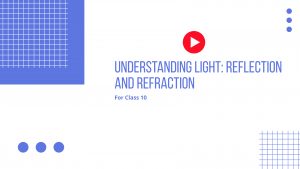NCERT Solutions for Maths Class 10 Chapter 4
Exercise 4.1
Question 1: Check whether the following are quadratic equations:
(i) \((x_1)^2=2(x-3)\)
(ii) \(x^2-2x=(-2)(3-x)\)
(iii) \((x-2)(x+1)=(x-1)(x+3)\)
(iv) \((x-3)(2x+1)=x(x+5)\)
(v) \((2x-1)(x-3)=(x+5)(x-1)\)
(vi) \(x^2+3x+1=(x-2)^2\)
(vii) \((x+2)^3=2x(x^2-1)\)
(viii) \(x^34x^2-x+1=(x-2)^2\)
Answer:
(i) \((x+1)^2=2(x-3)\)
\(⇒x^2+2x+1=2x-6\)
\(⇒x^2+7=0\)
It is of the form \(ax^2+bx+c=0\)
Hence, the given equation is a quadratic equation.
(ii) \(x^2-2x(-2)(3-x)\)
\(⇒x^2-2x=-6+2x\)
\(⇒x^2-4x+6=0\)
It is of the form \(ax^2+bx+c=0\)
Hence, the given equation is a quadratic equation.
(iii) \((x-2)(x+1)=(x-1)(x+3)\)
\(⇒x^2-x-2=x^2+2x-3\)
\(⇒3x-1=0\)
It is not of the form \(ax^2+bc+c=0\)
Hence, the given equation is not a quadratic equation.
(iv) \((x-3)(2x+1)=x(x+5)\)
\(⇒2x^2-5x-3=x^2+5x\)
\(⇒x^2-10x-3=0\)
It is of the form \(ax^2+bx+c=0\)
Hence, the given equation is a quadratic equation.
(v) \((2x-1)(x-3)=(x+5)(x-1)\)
\(⇒2x^2-7x+3=x^2+4x-5\)
\(⇒x^2-11x+8=0\)
It is of the form \(ax^2+bx+c=0\)
Hence, the given equation is a quadratic equation.
(vi) \(x^2+3x+1=(x-2)^2\)
\(⇒x^2+3x+1=x^2+4-4x\)
\(⇒7x-3=0\)
It is not of the form \(ax^2+bc+c=0\)
Hence, the given equation is not a quadratic equation.
(vii) \((x+2)^3=2x(x^2-1)\)
\(⇒x^3+8+6x^2+12x=2x^3-2x\)
\(⇒x^3-14x-6x^2-8=0\)
It is not of the form \(ax^2+bc+c=0\)
Hence, the given equation is not a quadratic equation.
(viii) \(x^3-4x^3-x+1=(x-2)^3\)
\(⇒x^3-4x^2-x+1=x^3-8-6x^2+12x\)
\(⇒2x^2-13x+9=0\)
It is of the form \(ax^2+bx+c=0\)
Hence, the given equation is a quadratic equation.
Question 2: Represent the following situations in the form of quadratic equations.
(i) The area of a rectangular plot is \(528 m^2\). The length of the plot (in metres) is one more than twice its breadth. We need to find the length and breadth of the plot.
(ii) The product of two consecutive positive integers is \(306\). We need to find the integers.
(iii) Rohan’s mother is \(26\) years older than him. The product of their ages (in years) \(3\) years from now will be \(360\). We would like to find Rohan’s present age.
(iv) A train travels a distance of \(480\) km at a uniform speed. If the speed had been \(8\) km/h less, then it would have taken 3 hours more to cover the same distance. We need to find the speed of the train.
Answer:
(i) Let the breadth of the plot be \(x\) m.
Hence, the length of the plot is \((2x + 1)\) m.
Area of a rectangle = Length × Breadth
\(∴ 528 = x (2x + 1)\)
\(⇒2x^2+x-528=0\)
(ii) Let the consecutive integers be \(x\) and \(x + 1\).
It is given that their product is \(306\)
\(∴x(x+1)=306\)
\(⇒x^2+x-306=0\)
(iii) Let Rohan’s age be \(x\)
Hence, his mother’s age \(= x + 26\)
\(3\) years hence,
Rohan’s age \(= x + 3\)
Mother’s age \(= x + 26 + 3 = x + 29\)
It is given that the product of their ages after \(3\) years is \(360\).
\(∴(x+3)(x+29)=360\)
\(⇒x^2+32x-273=0\)
(iv) Let the speed of train be \(x\) km/h.
Time taken to travel \(480\) km \(=\frac{480}{x}\) hrs.
In second condition, let the speed of train \(=(x-8)km/h\)
It is also given that the train will take \(3\) hours to cover the same distance.
Therefore, time taken to travel \(480\) km \(=(\frac{480}{x}+3)\) hrs.
Speed × Time = Distance
\((x-8)(\frac{480}{x}+3)=480\)
\(⇒480+3x-\frac{3840}{x}-24=480\)
\(⇒3x-\frac{3840}{x}=24\)
\(⇒3x^2-24x+3840=0\)
\(⇒x^2-8x+1280=0\)
Exercise 4.2
Question 1: Find the roots of the following quadratic equations by factorisation:
(i) \(x^2-3x-10=0\)
(ii) \(2x^2+x-6=0\)
(iii) \(\sqrt2x^2+=7x+5\sqrt2=0\)
(iv) \(2x^2-x+\frac{1}{8}=0\)
(v) \(100x^2-20x+1=0\)
Answer:
(i) \(x^2-3x-10\)
\(=x^2-5x+2x-10\)
\(=x(x-5)+2(x-5)\)
Roots of this equation are the values for which \((x-5)(x+2)=0\)
\(∴x-5= 0 or x+2=0\)
i.e., \(x=5 or x=-2\)
Correct: \(x=5\) or \(x=-2\)
(ii) \(2x^2+x-6\)
\(=2x^2+4x-3x-6\)
\(=2x(x+2)-3(x+2)\)
\(=(x+2)(2x-3)\)
Roots of this equation are the values for which \((x+2)(2x-3= 0\)
\(∴x+2=0\) or \(2x-3=0\)
i.e., \(x=-2\) or \(x =\frac{3}{2}\)
Correct: \(x=-2\) or \(x=\frac{3}{2}\)
(iii) \(\sqrt2 x^2+7x+5\sqrt2\)
\(=\sqrt2 x^2+5x+2x+5\sqrt2\)
\(=x(\sqrt2 x+5)+\sqrt2(\sqrt2 x+5)\)
\(=(\sqrt2 x+5)(x+\sqrt2)\)
Roots of this equation are the values for which \((\sqrt2 x+5)(x+\sqrt2)=0\)
\(∴\sqrt2 x+5=0 or x+\sqrt2=0\)
i.e., \(x=-\frac{5}{\sqrt2}\) or \(x =-\sqrt2\)
Correct: \(x=-\frac{2}{\sqrt5}\) or \(x =-\sqrt2\)
(iv) \(2x^2-x+\frac{1}{8}\)
\(=\frac{1}{8}(16x^2-8x+1)\)
\(=\frac{1}{8}(16x^2-4x-4x+1)\)
\(=\frac{1}{8}(4x(4x-1)-1(4x-1)\)
\(=\frac{1}{8} (4x-1)^2\)
Roots of this equation are the values for which \((4x-1)^2=0\)
Therefore, \((4x-1)=0\) or \((4x-1)=0\)
i.e., \(x=\frac{1}{4}\) or \(=\frac{1}{4}\)
Correct: \(x=\frac{1}{4}\) or \(=\frac{1}{4}\)
(v) \(100x^2-20x+1\)
\(=100x^2-10x-10x+1\)
\(=10x(10x-1)-1(10x-1)\)
\(=(10x-1)^2\)
Roots of this equation are the values for which \((10x-1)^2=0\)
Therefore, \((10x-1)=0\) or \((10x-1)=0\)
i.e., \(x=\frac{1}{10}\) or \(x=\frac{1}{10}\)
Correct: \(x=\frac{1}{10}\) or \(x=\frac{1}{10}\)
Question 2:
(i) A cottage industry produces a certain number of toys in a day. The cost of production of each toy (in John and Jivanti together have 45 marbles. Both of them lost 5 marbles each, and the product of the number of marbles they now have is 124. Find out how many marbles they had to start with.
(ii) Rupees was found to be 55 minus the number of toys produced in a day. On a particular day, the total cost of production was Rs 750. Find out the number of toys produced on that day.
Answer:
(i) Let the number of John’s marbles be \(x\).
Therefore, number of Jivanti’s marble \(= 45 – x\)
After losing \(5\) marbles,
Number of John’s marbles \(= x – 5\)
Number of Jivanti’s marbles \(= 45 – x – 5 = 40 – x\)
It is given that the product of their marbles is \(124\).
\(∴(x-5)(40-x)=124\)
\(⇒x^2-45x+324=0\)
\(⇒x^2-36x-9x+324=0\)
\(⇒x(x-36)-9(x-36)=0\)
\(⇒(x-36)(x-9)=0\)
Either \(= 0\) or x \(- 9 = 0\)
i.e., \(x = 36\) or \(x = 9\)
If the number of John’s marbles \(= 36,\)
Then, number of Jivanti’s marbles \(= 45 – 36 = 9\)
If number of John’s marbles \(= 9\),
Then, number of Jivanti’s marbles \(= 45 – 9 = 36\)
Correct: \(x = 36\) or \(x = 9\)
(ii) Let the number of toys produced be \(x\).
\(∴\) Cost of production of each toy \(= Rs (55 – x)\)
It is given that, total production of the toys \( = Rs\space 750\)
\(∴x(55-x)=750\)
\(⇒x^2-55x+750=0\)
\(⇒x^2-25x-30x+750=0\)
\(⇒x(x-25)-30(x-25)=0\)
\(⇒(x-25)(x-30)=0\)
Either \(=0\) or \(x-30=0\)
i.e., \(x=25\) or \(x=30\)
Hence, the number of toys will be either \(25\) or \(30\).
Question 4: Which of the following are APs? If they form an A.P. find the common difference d and write three more terms.
(i) \(2,\space 4,\space 8,\space 16 …\)
(ii) \(2,\space\frac{5}{2},\space 3,\space\frac{7}{2} …….\)
(iii) \(- 1.2, – 3.2, – 5.2, – 7.2 …\)
(iv) \(– 10,\space – 6,\space – 2,\space 2 …\)
(v) \( 3, 3+\sqrt2,3+2\sqrt2, 3+3\sqrt2\)
(vi) \(0.2, 0.22, 0.222, 0.2222 ….\)
(vii) \(0, – 4, – 8, – 12 …\)
(viii) \(-\frac{1}{2}, -\frac{1}{2} , -\frac{1}{2}, -\frac{1}{2}\)
(ix) \(1, 3, 9, 27 …\)
(x) \(a, 2a, 3a, 4a …\)
(xi) \(a, a^2, a^3, a^4 …\)
(xii) \(\sqrt2, \sqrt8, \sqrt18, \sqrt{32}……\)
(xiii) \(\sqrt3, \sqrt6, \sqrt9, \sqrt{12}……\)
(xiv)) \(1^2, 3^2, 5^2, 7^2 …\)
(xv) \(1^2, 5^2, 7^2, 73\)
Answer:
(i) \(2, 4, 8, 16 …\)
It can be observed that
\(a_2-a_1=4-2=2\)
\(a_3-a_2=8-4=4\)
\(a_4-a_3=16-8=8\)
i.e., \(ak+1-ak\) is not the same every time.
Therefore, the given numbers are not forming an A.P.
(ii) It can be observed that
\(a_2-a=\frac{5}{2}-2=\frac{1}{2}\)
\(a_3-a_2=3-\frac{5}{2}=\frac{1}{2}\)
\(a_4-a_3=\frac{7}{2}-3=\frac{1}{2}\)
i.e., \(ak+1-ak\) is same every time.
Therefore, \(d=\frac{1}{2}\) and the given numbers are in A.P.
Three more terms are
\(a_5=\frac{7}{2}+\frac{1}{2}=4\)
\(a_6=4+\frac{1}{2}=\frac{9}{2}\)
\(a_7=\frac{9}{2}+\frac{1}{2}=5\)
(iii) \(-1.2,\space -3.2,\space -5.2,\space -7.2\) …
It can be observed that
\(a_2 – a_1 = (-3.2) – (-1.2) = -2\)
\(a_3 – a_2 = (-5.2) – (-3.2) = -2\)
\(a_4 – a_3 = (-7.2) – (-5.2) = -2\)
i.e., ak+1- ak is same every time.
Therefore, \(d = -2\) The given numbers are in A.P.
Three more terms are
\(a_5 = – 7.2 – 2 = -9.2\)
\(a_6 = – 9.2 – 2 = -11.2\)
\(a_7 = – 11.2 – 2 = -13.2\)
(iv) \(-10, -6, -2, 2 …\)
It can be observed that
\(a_2 – a_1 = (-6) – (-10) = 4\)
\(a_3 – a_2 = (-2) – (-6) = 4\)
\(a_4 – a_3 = (2) – (-2) = 4\)
i.e., \(ak+1 – ak\) is same every time.
Therefore, \(d = 4\) the given numbers are in A.P.
Three more terms are
\(a_5 = 2 + 4 = 6\)
\(a_6 = 6 + 4 = 10\)
\(a_7 = 10 + 4 = 14\)
(v) \(3,3+\sqrt2, 3+2\sqrt2, 3+3\sqrt2, …..\)
It can be observed that
\(a_2-a_1=3+\sqrt2-3=\sqrt2\)
\(a_3-a_2=3+2\sqrt2-3-\sqrt2=\sqrt2\)
\(a_4-a_3=3+3\sqrt2-3-2\sqrt2=\sqrt2\)
i.e., \(ak+1-ak\) is same every time. Therefore,
The given numbers are in A.P.
Three more terms are
(vi) \(0.2, 0.22, 0.222, 0.2222 ….\)
It can be observed that
\(a_2 − a_1 = 0.22 − 0.2 = 0.02\)
\(a_3 − a_2 = 0.222 − 0.22 = 0.002\)
\(a_4 − a_3 = 0.2222 − 0.222 = 0.0002\) i.e.,
\(ak+1-ak\) is not the same every time.
Therefore, the given numbers are not in A.P.
(vii) \(0,\space −4,\space −8,\space −12 …\)
It can be observed that
\(a_2 − a_1 = (−4) − 0 = −4\)
\(a_3 − a_2 = (−8) − (−4) = −4\)
\(a_4 − a_3 = (−12) − (−8) = −4\)
i.e., is same every time. Therefore, \(d = −4\)
The given numbers are in A.P.
Three more terms are
\(a_5 = − 12 − 4 = −16\)
\(a_6 = − 16 − 4 = −20\)
\(a_7 = − 20 − 4 = −24\)
(viii) \(-\frac{1}{2},\space-\frac{1}{2},\space-\frac{1}{2},\space-\frac{1}{2}…..\)
It can be observed that
\(a_2-a_1=(-\frac{1}{2})-(-\frac{1}{2})=0\)
\(a_3-a_2=(-\frac{1}{2})-(-\frac{1}{2}=0\)
\(a_4-a_3=(-\frac{1}{2})-(-\frac{1}{2})=0\)
i.e. \(ak+1-ak\) is same every time.
Therefore, \(d=0\)
The given numbers are in AP.
Three more terms are
\(a_5=-\frac{1}{2}0=-\frac{1}{2}\)
\(a_6=-\frac{1}{2}0=-\frac{1}{2}\)
\(a_7=-\frac{1}{2}0=-\frac{1}{2}\)
(ix) \(1,\space 3,\space 9,\space 27 …\)
It can be observed that
\(a_2 – a_1 = 3 – 1 = 2\)
\(a_3 – a_2 = 9 – 3 = 6\)
\(a_4 – a_3 = 27 – 9 = 18\)
i.e., \(ak+1 – ak\) is not the same every time.
Therefore, the given numbers are not in A.P.
(x) \(a, 2_a, 3_a, 4_a …\)
It can be observed that
\(a_2 – a_1 = 2a – a = a\)
\(a_3 – a_2 = 3a – 2a = a\)
\(a_4 – a_3 = 4a – 3a = a\)
i.e., \(ak+1 – ak\) is same every time.
Therefore, \(d = a\)
The given numbers are in A.P.
Three more terms are
\(a_5 = 4a + a = 5a\)
\(a_6 = 5a + a = 6a\)
\(a_7 = 6a + a = 7a\)
(xi) \(a,\space a^2,\space a^3,\space a^4……\)
It can be observed that
\(a_2-a_1=a^2-a=a(a-1)\)
\(a_3-a_2=a^3-a^2=a^2(a-1)\)
\(a_4-a_3=a^4-a^3=a^3(a-1)\)
i.e. \(ak+1-ak\) is not the same every time.
Therefore, the given numbers are not in A.P.
(xii) \(\sqrt2,\space\sqrt8,\space\sqrt{18},\space\sqrt{323}….\)
\(a_2-a_1=\sqrt8-\sqrt2=2\sqrt2-\sqrt2=\sqrt2\)
\(a_3-a_1=\sqrt{18}-\sqrt8=3\sqrt2-2\sqrt2=\sqrt2\)
\(a_4-a_3=\sqrt{32}-\sqrt{18}=4\sqrt2-3\sqrt2=\sqrt2\)
i.e., \(ak+1-ak\) is same every time.
Therefore, the given numbers are in A.P.
And, \(d=\sqrt2\)
Three more terms are
\(a_3=\sqrt{32}+\sqrt2=4\sqrt2+\sqrt2=5\sqrt2=\sqrt{50}\)
\(a_6=5\sqrt2+\sqrt2=\sqrt{62}=\sqrt{72}\)
\(a_7=6\sqrt2+\sqrt2=7\sqrt2=\sqrt{98}\)
(xiii) \(\sqrt3 ,\space\sqrt6 ,\sqrt9 ,\space\sqrt12………\)
It can be observed that
\(⇒a_2-a_1=\sqrt6-\sqrt3\)
\(⇒\sqrt{3×2}-\sqrt3=\sqrt3{\sqrt2-1}\)
\(⇒a_3-a_2=\sqrt9-\sqrt6\)
\(⇒3-\sqrt6=\sqrt3(√2-√2)\)
\(⇒a_4-a_3=\sqrt{12}-\sqrt9\)
\(⇒2\sqrt3-\sqrt{3×3}=\sqrt3(2-√3)\)
i.e., \(ak+1-ak\) is not the same every time.
Therefore, the given numbers are not in A.P.
(xiv) \(1^2, 3^2, 5^2, 7^2 …\)
Or, \(1,\space 9,\space 25,\space 49 …..\)
It can be observed that
\(a_2 − a_1 = 9 − 1 = 8\)
\(a_3 − a_2 = 25 − 9 = 16\)
\(a_4 − a_3 = 49 − 25 = 24\)
i.e., \(ak+1-ak\) is not the same every time.
Therefore, the given numbers are not in A.P.
(xv) \(1^2, 5^2, 72, 73 …\)
Or \(1,\space 25,\space 49,\space 73 …\)
It can be observed that
\(a_2 − a_1 = 25 − 1 = 24\)
\(a_3 − a_2 = 49 − 25 = 24\)
\(a_4 − a_3 = 73 − 49 = 24\)
i.e., \(ak+1-ak\) is same every time.
Therefore, the given numbers are in A.P. And, \(d = 24\)
Three more terms are
\(a_5 = 73+ 24 = 97\)
\(a_6 = 97 + 24 = 121\)
\(a_7 = 121 + 24 = 145\)
Question 3: Find two numbers whose sum is 27 and product is 182.
Answer:
Let the first number be \(x\) and the second number is \(27 – x.\)
Therefore, their product \(= x (27 – x)\)
It is given that the product of these numbers is \(182\).
Therefore, \(x(27-x)=182\)
\(⇒x^2-27x+182=0\)
\(⇒x^2-13x-14x+182=0\)
\(⇒x(x-13)-14(x-12)=0\)
\(⇒(x-13)(x-14)=0\)
Either \(x-13=0\) or \(x-14=0\)
i.e., \(x=13\) or \(x=14\)
If first number \(= 13\), then
Other number \(= 27 – 13 = 14\)
If first number \(= 14\), then
Other number \(= 27 – 14 = 13\)
Therefore, the numbers are \(13\) and \(14\).
Question 4: Find two consecutive positive integers, sum of whose squares is \(365\).
Answer: Let the consecutive positive integers be \(x\) and \(x + 1\)
Given that \(x^2+(x+1)^2=365\)
\(⇒x^2+x^2+1+2x=365\)
\(⇒2x^2+2x-364=0\)
\(⇒x^2+x-182=0\)
\(⇒x^2+14x-13x-182=0\)
\(⇒x(x+14)-13(x+14)=0\)
\(⇒(x+14)(x-13)=0\)
Either x\(+14=0\) or \(x-13=0\), i.e., \(x =-14\) or \(x = 13\)
Since the integers are positive, \(x\) can only be \(13\).
\(∴ x + 1 = 13 + 1 = 14\)
Therefore, two consecutive positive integers will be 13 and 14.
Question 5: The altitude of a right triangle is \(7\) cm less than its base. If the hypotenuse is \(13) cm, find the other two sides.
Answer:
Let the base of the right triangle be \(x\) cm.
Its altitude \(= (x – 7)\) cm
From Pythagoras theorem,
\(Base^2+Altitude^2=Hypotenuse^2\)
\(∴x^2+(x-7)^2=13^2\)
\(⇒x^2+x^2+49-14x=169\)
\(⇒2x^2-14x-120=0\)
\(⇒x^2-7x-60=0\)
\(⇒x^2-12x+5x-60=0\)
\(⇒x(x-12)+5(x-12)=0\)
\(⇒(x-12)(x+5)=0\)
Either \(x – 12 = 0\) or \(x + 5 = 0\), i.e., \(x = 12\) or \(x = -5\) Since sides are positive, \(x\) can only be \(12\).
Therefore, the base of the given triangle is \(12\) cm and the altitude of this triangle will be \((12 – 7)\) cm \(= 5\) cm.
Question 6: A cottage industry produces a certain number of pottery articles in a day. It was observed on a particular day that the cost of production of each article (in rupees) was \(3\) more than twice the number of articles produced on that day. If the total cost of production on that day was Rs \(90\), find the number of articles produced and the cost of each article.
Answer: Let the number of articles produced be \(x\).
Therefore, cost of production of each article = Rs \((2x + 3)\) It is given that the total production is Rs \(90\).
\(∴x(2x+3)=90\)
\(⇒2x^2+3x-90=0\)
\(⇒2x^2+15x-12x-90=0\)
\(⇒x(2x+15)-6(2x+15)=0\)
\(⇒(2x+15)(x-6)=0\)
Either \(2x + 15 = 0\) or \(x – 6 = 0\), i.e., \(x = -\frac{15}{2}\) or \(x = 6\)
As the number of articles produced can only be a positive integer,
Therefore, \(x\) can only be \(6\).
Hence, number of articles produced \(=6\)
Cost of each article \(= 2 × 6 + 3\) = Rs \(15\)
Exercise 4.3
Question 1: Find the roots of the following quadratic equations, if they exist, by the method of completing the square:
(i) \(2x^2-7x+3=0\)
(ii) \(2x^2+x-4=0\)
(iii) \(4x^2+4\sqrt{3x}+3=0\)
(iv) \(2x^2+x+4=0\)
Answer:
(i) \(2x^2-7x+3=0\)
\(⇒2x^2-7x=-3\)
On dividing both sides of the equation by 2, we obtain
\(⇒x^2-\frac{7}{2}x=-\frac{3}{2}\)
\(⇒x^2-2\times{x}\times\frac{7}{4}=-\frac{3}{2}\)
On adding \((\frac{7}{4})^2\)
\(⇒(x)^2-2\times{x}\times\frac{7}{4}+(\frac{7}{4})^2=(\frac{7}{4})^2-\frac{3}{2}\)
\(⇒(x-\frac{7}{4})^2=\frac{49}{16}-\frac{3}{2}\)
\(⇒(x-\frac{7}{4})^2=\frac{25}{16}\)
\(⇒(x-\frac{7}{4})=±\frac{5}{4}\)
\(⇒x=\frac{7}{4}±\frac{5}{4}\)
\(⇒x=\frac{7}{4}+\frac{5}{4}\) or \(x=\frac{7}{4}-\frac{5}{4}\)
\(⇒x=\frac{12}{4}\) or \(x=\frac{2}{4}\)
\(⇒x=3\) or \(\frac{1}{2}\)
(ii) \(2x^2+x-4=0\)
\(⇒2x^2+x=4\)
On dividing both sides of the equation by 2, we obtain
\(⇒x^2+\frac{1}{2}x=2\)
On addong (\(\frac{1}{4})^2\) to both sides of the equation, we obtain
\(⇒(x)^2+2\times{x}\times\frac{1}{4}+(\frac{1}{4})^2=2+(\frac{1}{4})^2\)
\(⇒(x+\frac{1}{4})^2=\frac{33}{16}\)
\(⇒x+\frac{1}{4}=\pm\frac{\sqrt{33}}{4}\)
\(⇒x=\frac{\pm\sqrt{33}-1}{4}\) or \(\frac{-\sqrt{33}-1}{4}\)
(iii) \(4x^2+4\sqrt3x+3=0\)
\(⇒(2x)^2+2\times2x\times\sqrt3+(\sqrt3)^2=0\)
\(⇒(2x+\sqrt3)^2=0\)
\(⇒(2x+\sqrt3)=0\) and \((2x+\sqrt3)=0\)
\(⇒x=-\frac{\sqrt3}{2}\) and \(=-\frac{\sqrt3}{2}\)
(iv) \(2x^2+x+4=0\)
\(⇒2x^2+x=-4\)
On dividing both sides of the equation by 2, we obtain
\(⇒x^2+\frac{1}{2}x=-2\)
\(⇒x^2+2\times{x}\times\frac{1}{4}=-2\)
On adding \((\frac{1}{4})^2\) to both sides of the equation, we obtain
\(⇒(x)^2+2\times{x}\times\frac{1}{4}+(\frac{1}{4})^2=(\frac{1}{4})^2-2\)
\(⇒(x=\frac{1}{4})^2=-\frac{1}{16}-2\)
\(⇒(x+\frac{1}{4})^2=-\frac{31}{16}\)
However, the square of a number cannot be negative.
Therefore, there is no real root for the given equation.
Question 2: Find the roots of the quadratic equations by applying the quadratic formula
\(2x^2-7x+3=0\)
Answer: \(2x^2-7x+3=0\)
On comparing this equation with \(ax^2+bx+c=0\)
We obtain \(a=2,\space b=-7,\space c=3\)
By using quadratic fromula, we obtain
\(x=\frac{-b\pm\sqrt{b^2-4ac}}{2a}\)
\(⇒x=\frac{7\pm\sqrt{49-24}}{4}\)
\(⇒x=\frac{7\pm\sqrt{25}}{4}\)
\(⇒x=\frac{7\pm5}{4}\)
\(⇒x=\frac{7\pm5}{4}\) or \(\frac{7-5}{4}\)
\(⇒x=\frac{12}{4}\) or \(\frac{2}{4}\)
\(∴x=3\) or \(\frac{1}{2}\)
(ii) \(2x^2+x-4=0\)
One comparing this equation with \(ax^2+bx+c=0\), we obtain \(a=2,\space b=1,\space c=-4\) by using quadratic formula, we obtain
\(x=\frac{-b\pm\sqrt{b^2-4ac}}{2a}\)
\(⇒x=frac{-1\pm\sqrt{1+32}}{4}\)
\(⇒x=\frac{-1\pm\sqrt{33}}{4}\)
\(∴x=\frac{-1+\sqrt{33}}{4}\) or \(\frac{-1-\sqrt{33}}{4}\)
(iii) \(4x^2+4\sqrt3x+3=0\)
On comparing this equation with \(ax^2+bx+c=0\), we obtain
\(a=4\), \(b=4\sqrt3\), \(c=3\)
By using quadratic formula, we obtain
\(x=\frac{-b\pm\sqrt{b^2-4ac}}{2a}\)
\(⇒x=\frac{-4\sqrt3\pm\sqrt{48-48}}{8}\)
\(⇒x=\frac{-4\sqrt3\pm0}{8}\)
\(∴ x=\frac{-4\sqrt3}{2}\) or \(\frac{-\sqrt3}{2}\)
(iv) \(2x^2+x+4=0\)
On comparing this equation with \(ax^2+bx+c=0\), we pobtain
\(a=2,\space b=1, c=4\)
By using quadratic formula,we obtain
\(x=\frac{-b\pm\sqrt{b^2-4ac}}{2a}\)
\(⇒x=\frac{-1\pm\sqrt{1-32}}{4}\)
\(⇒x=\frac{-1\sqrt{1-32}}{4}\)
However, the square of a number cannot be negative.
Therefore, there is no root the given equation.
Question 3: Find the roots of the following equation:
(i) \(x-\frac{1}{x}=3,\space x\ne0\)
(ii) \(\frac{1}{x+4}-\frac{1}{x-7}=\frac{11}{30},\space\ne-4,\space7\)
Answer:
(i) \(x-\frac{1}{3}⇒x^2-3x-1=0\)
On comparing this equation with \(ax^2+bx+c=0\), we obtain \(a=1,\space b=-3,\space c=-1\)
By using quadratic formula, we obtain
\(x=\frac{-b\pm\sqrt{b^2-4ac}}{2a}\)
\(⇒x=\frac{3\pm\sqrt{9=4}}{2}\)
\(⇒x=\frac{3\pm\sqrt{9+4}}{2}\)
\(∴=x=\frac{3+\sqrt{13}}{2}\) or \(\frac{3-\sqrt{13}}{2}\)
(ii) \(\frac{1}{x+4}-\frac{1}{x-7}=\frac{11}{30}\)
\(⇒\frac{x-7-x-4}{(x+4)(x-7)}=\frac{11}{30}\)
\(⇒\frac{-11}{(x+4)(x-7)}=\frac{11}{30}\)
\(⇒(x+4)(x-7)=-30\)
\(⇒x^2-3x-28=-30\)
\(⇒x^2-3x+2=0\)
\(⇒x^2-2x-x+2=0\)
\(⇒x(x-2)-1(x-2)=0\)
\(⇒(x-2)(x-1)=0\)
\(⇒x=1\) or \(2\)
Question 4: The sum of the reciprocals of Rehman’s ages, (in years) 3 years ago and 5 years from now is. Find his present age.
Answer: Let the present age of Rehman be \(x\) years.
Three years ago, his age was \((x – 3)\) years.
Five years hence, his age will be \((x + 5)\) years.
It is given that the sum of the reciprocals of Rehman’s ages \(x\) years ago and \(5\) years from now is \(\frac{1}{3}\) .
\(∴\frac{1}{x-3}+\frac{1}{x+5}=\frac{1}{3}\)
\(\frac{x+5+x-3}{(x-3)(x+5)}=\frac{1}{3}\)
\(\frac{2x+2}{(x-3)(x+5)}=\frac{1}{3}\)
\(⇒3(2x+2)=(x-3)(x+5)\)
\(⇒6x+6=x^2+2x-15\)
\(⇒x^2-4x-21=0\)
\(⇒x^2-7x+3x-21=0\)
\(⇒x(x-7)+3(x-7)=0\)
\(⇒x=7,\space -3\)
However, age cannot be negative.
Therefore, Rehman’s present age is \(7\) years.
Question 5: In a class test, the sum of Shefali’s marks in Mathematics and English is 30. Had she got 2 marks more in Mathematics and 3 marks less in English, the product of their marks would have been 210. Find her marks in the two subjects.
Answer:
Let the marks in Maths be \(x\).
Then, the marks in English will be \(30 – x\)
According to the given question,
\((x+2)(30-x-3)=210\)
\((x+2)(27-x)=210\)
\(⇒-x^2+25x+54=210\)
\(⇒x^2+25x+54=210\)
\(⇒x^2-12x-13x+156=0\)
\(⇒x(x-12)-13+156=0\)
\(⇒(x-12)(x-13)=0\)
\(⇒x=12,\space 13\)
If the marks in Maths are \(12\), then marks in English will be \(30 – 12 = 18\)
If the marks in Maths are 13, then marks in English will be \(30 – 13 = 17\)
Question 6: The diagonal of a rectangular field is 60 metres more than the shorter side. If the longer side is 30 metres more than the shorter side, find the sides of the field.
Answer: Let the shorter side of the rectangle be \(x\) m.
Then, larger side of the rectangle \(= (x + 30)\) m
Diagonal of the rectangle \(=\sqrt{x^2+(x+30)^2}\)
It is given that the diagonal of the rectangle is \(60\) m more than the shorter side
\(∴\sqrt{(x^2+x+30)^2}=x+60\)
\(⇒x^2+(x+30)^2=(x+60)^2\)
\(⇒x^2+x^2+900+60x=x^2+3600+120x\)
\(⇒x^2-60x-2700=0\)
\(⇒x^2-90x+30x-2700=0\)
\(⇒x(x-90)+30(x-90)\)
\(⇒(x-90)(x+30)=0\)
\(⇒x=90, -30\)
However, side cannot be negative. Therefore, the length of the shorter side will be \(90\) m.
Hence, length of the larger side will be \((90 + 30)\space m = 120\space m\)
Question 7: The difference of squares of two numbers is 180. The square of the smaller number is 8 times the larger number. Find the two numbers.
Answer:
Let the larger and smaller number be \(x\) and \(y\) respectively.
According to the given question,
\(x^2-y^2=180\) and \(y^2=8x\)
\(⇒x^2-8x=180\)
\(⇒x^2-8x-180=0\)
\(⇒x^2-18x+10x-180=0\)
\(⇒x(x-18)+10(x-18)=0\)
\(⇒(x-18)(x+10)=0\)
\(⇒x=18, -10\)
However, the larger number cannot be negative as 8 times of the larger number will be negative and hence, the square of the smaller number will be negative which is not possible.
Therefore, the larger number will be 18 only.
\(x=18\)
\(∴y^2=8x=8×18=144\)
\(⇒y=±\sqrt{144}=±12\)
\(∴\)Smaller number \(=±12\)
Therefore, the numbers are \(18\) and \(12\) or \(18\) and \(-12\)
Question 8: A train travels 360 km at a uniform speed. If the speed had been 5 km/h more, it would have taken 1 hour less for the same journey. Find the speed of the train.
Answer:
Let the speed of the train be \(x\) km/hr.
Tike taken to cover 360 km \(=\frac{360}{x}\) hr.
According to the given question,
\((x+5)(\frac{360}{x}-1)=360\)
\(⇒(x+5)(\frac{360}{x}-1)=360\)
\(⇒360-x+\frac{1800}{x}-5=360\)
\(⇒x^2+5x-1800=0\)
\(⇒x^2+45x-40x-1800=0\)
\(⇒x(x+45)-40(x+45)=0\)
\(⇒(x+45)x-40)=0\)
\(⇒x=40, -45\)
However, speed cannot be negative.
Therefore, the speed of train is 40 km/h
Question 9: Two water taps together can fill a tank in \(9\frac{3}{8}\) hours. The tap of larger diameter takes 10 hours less than the smaller one to fill the tank separately. Find the time in which each tap can separately fill the tank.
Answer:
Let the time taken by the smaller pipe to fill the tank be \(x\) hr.
Time taken by the larger pipe \(= (x – 10)\) hr.
Part of tank filled by smaller pipe in 1 hour =
Part of tank filled by larger pipe in 1 hour =
It is given that the tank can be filled in \(9\frac{3}{8}=\frac{75}{8}\) hours by both the pipes together.
Therefore,
\(\frac{1}{x}+\frac{1}{x-10}=\frac{8}{75}\)
\(⇒\frac{2x-10}{x(x-10)}=\frac{8}{75}\)
\(⇒75(2x-10)=8x^2-80x\)
\(⇒150x-750=8x^2-80x\)
\(⇒8x^2-230x+750=0\)
\(⇒8x^2-230x+750=-\)
\(⇒8x(x-25)-30x(x-25)=0\)
\(⇒(x-25)(8x-30)=0\)
i.e. \(x=25,\space \frac{30}{8}\)
Time taken by the smaller pipe cannot be \(\frac{30}{8}=3.75\) hours. As in this case, the time taken by the larger pipe will be negative, which is logically not possible.
Therefore, time taken individually by the smaller pipe and the larger pipe will be \(25\) and \(25 – 10 =15\) hours respectively.
Correct: 15
Question 10:
An express train takes 1 hour less than a passenger train to travel 132 km between Mysore and Bangalore (without taking into consideration the time they stop at intermediate stations). If the average speeds of the express train is 11 km/h more than that of the passenger train, find the average speed of the two trains.
Answer:
Let the average speed of passenger train be \(x\) km/h.
Average speed of express train \(= (x + 11)\) km/h
It is given that the time taken by the express train to cover \(132\) km is \(1\) hour less than the passenger train to cover the same distance.
\(∴\frac{132}{x}-\frac{132}{x+11}=1\)
\(⇒132[\frac{x+11-x}{x(x+11)}]=1\)
\(⇒\frac{132\times11}{x(x+11)}=1\)
\(⇒132×11=x(x+11)\)
\(⇒x^2+11x-1452=0\)
\(⇒x^2+44x-33x-1452=0\)
\(⇒x(x+44)-33(x+44)=0\)
\(⇒(x+44)(x-33)=0\)
\(⇒x=44,33\)
Speed cannot be negative.
Therefore, the speed of the passenger train will be \(33\) km/h and thus, the speed of the express train will be \(33 + 11 = 44\) km/h.
Question 11: Sum of the areas of two squares is \(468\space m^2\). If the difference of their perimeters is \(24\) m, find the sides of the two squares.
Answer:
Let the sides of the two squares be \(x\) m and \(y\) m. Therefore, their perimeter will be \(4x\) and \(4y\) respectively and their areas will be \(x^2\) and \(y^2\) respectively.
It is given that
\(4x – 4y = 24\)
\(x – y = 6\)
\(x = y + 6\)
Also, \(x^2+y^2=468\)
\(⇒(6+y)^2+y^2=468\)
\(⇒36+y^2+12y+y^2=468\)
\(⇒2y^2+12y-432=0\)
\(⇒y^2+6y-216=0\)
\(⇒y^2+18y-12y-216=0\)
\(⇒y(y+18)-12(y+18)=0\)
\(⇒(y+18)(y-12)=0\)
\(⇒y=-18\) or \(12\)
However, side of a square cannot be negative.
Hence, the sides of the squares are \(12\) m and \((12 + 6) m = 18\) m
Exercise 4.4
Question 1: Find the nature of the roots of the following quadratic equations. If the real roots exist, find them:
(i) \(2x^2-3x+5=0\)
(ii) \(3x^2-4\sqrt3x+4=0\)
(iii) \(2x^2-6x+3=0\)
Answer:
We know that for a quadratic equation \(ax^2 + bx + c = 0\), discriminant is \(b^2 − 4ac\).
(a) If \(b^2 − 4ac > 0 →\) two distinct real roots
(b) If \(b^2 − 4ac = 0 →\) two equal real roots
(c) If \(b^2 − 4ac < 0 → \)no real roots
(i) \(2x^2 −3x + 5 = 0\)
Comparing this equation with \(ax^2 + bx + c = 0\), we obtain \(a = 2,\space b = −3,\space c = 5\)
Discriminant \(= b^2 − 4ac = (− 3)^2− 4 (2) (5) = 9 − 40 = −31\)
As \(b^2 − 4ac < 0\),
Therefore, no real root is possible for the given equation.
(ii) \(3x^2-4\sqrt3x+4=0\)
Comparing this equation with \(ax^2+bx+c=0\), we obtain \(a=3,\space b=-4\sqrt3,\space c=4\)
Discriminant \(=b^2-4ac=(-4\sqrt3)^2-4(3)(4)\)
\(=48-48=0\)
As \(b^2-4ac=0\)
Therefore, real roots exist for the given equation and they are equal to each other.
And the roots will be \(-\frac{b}{2a}\) and \(-\frac{b}{2a}\)
\(-\frac{b}{2a}=\frac{-(-4\sqrt3)}{2\times3}=\frac{4\sqrt3}{6}=\frac{2\sqrt3}{3}=\frac{2}{\sqrt3}\)
Therefore, the roots are \(\frac{2}{\sqrt3}\) and \(\frac{2}{\sqrt3}\)
(iii) \(2x^2 − 6x + 3 = 0\)
Comparing this equation with \(ax^2+ bx + c = 0\), we obtain
\(a = 2,\space b = −6,\space c = 3\)
Discriminant \(= b^2 − 4ac = (− 6)^2 − 4 (2) (3) = 36 − 24 = 12\)
As \(b^2 − 4ac > 0\),
Therefore, distinct real roots exist for this equation as follows.
\(x=\frac{-b\pm\sqrt{b^2-4ac}}{2a}\)
\(=\frac{-(-6)\pm\sqrt{(-6)^2-4(2)(3)}}{2(2)}\)
\(=\frac{6\pm\sqrt{12}}{4}=\frac{6\pm2\sqrt3}{4}\)
\(=\frac{3\pm\sqrt3}{2}\)
Therefore, the roots are \(\frac{3+\sqrt3}{2}\) or \(\frac{3-\sqrt3}{2}\)
Question 2: Find the values of \(k\) for each of the following quadratic equations, so that they have two equal roots.
(i) \(2x^2 + kx + 3 = 0\)
(ii) \(kx (x − 2) + 6 = 0\)
Answer:
We know that if an equation \(ax^2 + bx + c = 0\) has two equal roots, its discriminant
\((b^2 − 4ac)\) will be \(0\).
(i) \(2x^2 + kx + 3 = 0\)
Comparing equation with \(ax^2 + bx + c = 0\), we obtain \(a = 2,\space b = k,\space c = 3\)
Discriminant \(= b^2 − 4ac = (k)^2− 4(2) (3) = k^2 − 24\)
For equal roots,
Discriminant \(=0\)
\(k^2 − 24 = 0\)
\(k^2 = 24\)
(ii) \(kx (x − 2) + 6 = 0\)
or \(kx^2 − 2kx + 6 = 0\)
Comparing this equation with \(ax^2 + bx + c = 0\), we obtain \(a = k,\space b = −2k,\space c = 6\)
Discriminant \(= b^2 − 4ac = (− 2k)^2 − 4 (k) (6) = 4k^2 − 24k\)
For equal roots,
\(b^2 − 4ac = 0\)
\(4k^2− 24k = 0\)
\(4k (k − 6) = 0\)
Either \(4k = 0\) or \(k = 6 = 0\)
\(k = 0\) or \(k = 6\)
However, if \(k = 0\), then the equation will not have the terms’\(x^2\)’and \(‘x’\).
Therefore, if this equation has two equal roots, k should be \(6\) only.
Question 3: Is it possible to design a rectangular mango grove whose length is twice its breadth, and the area is \(800\space m^2\)?
If so, find its length and breadth.
Answer:
Let the breadth of mango grove be \(l\).
Length of mango grove will be \(2l\).
Area of mango grove \(= (2l) (l)\)
\(= 2l^2\)
\(2l^2=800\)
\(l^2=\frac{800}{2}=400\)
\(l^2=400=0\)
Comparing this equation with \(al^2 + bl + c = 0\), we obtain \(a = 1,\space b = 0,\space c = 400\)
Discriminant \(= b^2 – 4ac = (0)^2- 4 × (1) × (- 400) = 1600\)
Here, \(b^2 – 4ac > 0\)
Therefore, the equation will have real roots. And hence, the desired rectangular mango grove can be designed.
\(l=±20\)
However, length cannot be negative.
Therefore, breadth of mango grove \(= 20\) m
Length of mango grove \(= 2 × 20 = 40\) m
Question 4: Is the following situation possible? If so, determine their present ages. The sum of the ages of two friends is 20 years. Four years ago, the product of their ages in years was 48.
Answer:
Let the age of one friend be \(x\) years.
Age of the other friend will be \((20 − x)\) years.
4 years ago, age of \(1^{st}\) friend \(= (x − 4)\) years
And, age of \(2^{nd}\) friend \(= (20 − x − 4) = (16 − x)\) years
Given that,
\((x − 4) (16 − x) = 48\)
\(16x − 64 − x^2+ 4x = 48\)
\(x^2 + 20x − 112 = 0\)
\(x^2 − 20x + 112 = 0\)
Comparing this equation with \(ax^2 + bx + c = 0\), we obtain \(a = 1,\space b = −20,\space c = 112\)
\(= 400 − 448 = −48\)
As \(b^2 − 4ac < 0\),
Therefore, no real root is possible for this equation and hence, this situation is not possible.
Question 5: Is it possible to design a rectangular park of perimeter 80 and area 400 ? If so find its length and breadth.
Answer: Let the length and breadth of the park be \(l\) and \(b\). Perimeter \(=2 (l+ b)=80\)
\(l+ b = 40\)
Or, \(b = 40 – l\)
Area \(= l × b = l (40 – l) = 40l – l^2\)
\(40l – l^2= 400\)
\(l2 – 40l + 400 = 0\)
Comparing this equation with
\(al^2 + b l + c = 0\), we obtain
\(a = 1,\space b = -40, \space c = 400\)
Discriminate \(= b^2 – 4ac = (- 40)^2 -4 (1) (400) = 1600 – 1600 = 0\)
As \(b^2 – 4ac = 0\),
Therefore, this equation has equal real roots. And hence, this situation is possible.
Root of this equation,
\(l=-\frac{b}{2}\)
\(l=-\frac{(-40)}{2(1)}=\frac{40}{2}=20\)
Therefore, length of park, \(l=20\) m
And breath of park, \(b=40-l=40-20=20\) cm
Study materials
- Refernce Books
- NCERT Solutions
- Syllabus







